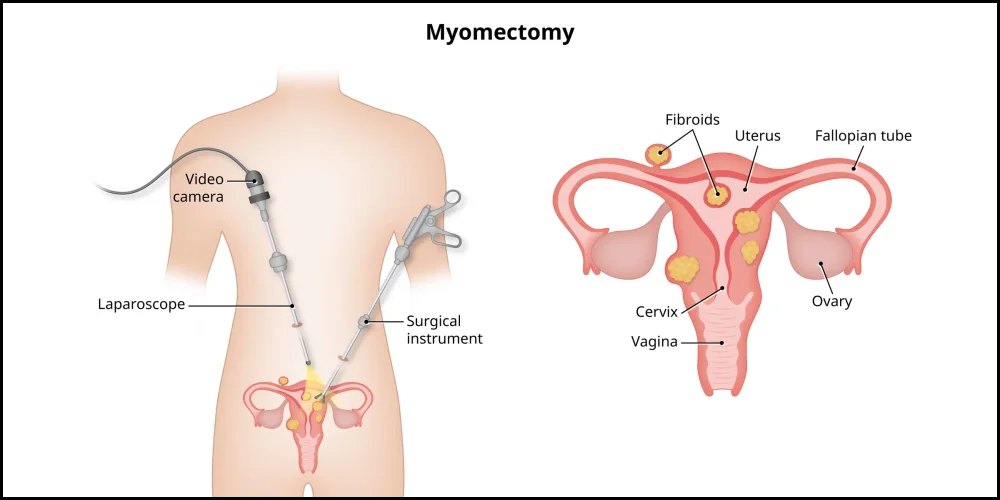Myomectomy Surgery
Removing Uine Fibroids and Enhancing Women's Health
Myomectomy is a procedure that aims to eliminate fibroids in the uterus and protecting the uterus. The procedure is usually advised for women who are experiencing symptoms like excessive menstrual bleeding, pelvic pain and infertility due to fibroids. In Chirayu Super Speciality Hospital, we specialize in myomectomy providing a variety of surgical procedures that are tailored to the individual requirements. Our mission is to offer an effective treatment that eases symptoms, improves quality of life and safeguards reproductive health. Our team of expert Gynecologists and surgeons is committed to providing the best quality of care that focuses on safety, precision and a warm, caring support.

What is Myomectomy Surgery?
Myomectomy is an operation that is designed to eliminate fibroids (also called leiomyomas) from the uterus, while protecting the uterus. Fibroids are benign growths that may cause range of symptoms, such as painful bleeding, heavy bleeding and pressure. The procedure is performed by a variety of approaches, based upon the extent, size and amount of fibroids and also the health of the patient overall. Myomectomy’s primary objective is to alleviate symptoms and improve the quality of life, while also preserving the fertility of the patient.
Who Performs Your Surgery?
In Chirayu Super Speciality Hospital, myomectomy surgeries are conducted by a group comprised of extremely skilled gynecologists as well as surgeons who have extensive experience treating fibroids in the uterus. Our doctors are experienced in a variety of myomectomy methods such as abdominal, laparoscopic and robotic-assisted techniques. They collaborate closely with other health experts to ensure complete medical attention throughout the procedure, focusing on the best results for every patient.
Types of Myomectomy Surgery
- Abdominal Myomectomy : It involves an incision that is open through the abdomen in order to eliminate fibroids. This method is typically employed for the removal of multiple or larger fibroids.
- Laparoscopic Myomectomy : A minimally-invasive method which involves small cuts within the abdomen and fibroids are removed with special instruments and an laparoscope.
- Robotic-Assisted Myomectomy : A form of laparoscopic surgery that uses robotics technology employed to increase accuracy and control when removing fibroids.
- Hysteroscopic Myomectomy : The procedure is performed through the vagina and cervical cervix with a hysteroscope, to eliminate fibroids that are located in the urinary cavity. This method is utilized to treat submucosal fibroids.
Symptoms Indicating the Need for Myomectomy Surgery
- Menstrual bleeding can be prolonged or severe that can affect everyday activities.
- Pressure or pain in the pelvis due to multiple or large fibroids.
- Infertility, or issues during pregnancy due to fibroids.
- Infrequent urination or difficulty in getting the bladder empty.
- Infertility and lower back discomfort due to the presence of fibroid.
Diagnosis for Myomectomy Surgery
Diagnostics typically involve a full examination that includes a pelvic exam or ultrasound MRI or examination using hysteroscopy that allows you to see and evaluate the fibroids. These tests aid in determining the size, location and amount of fibroids, and aid in planning the best surgical strategy. Gynecologists will go over the results and suggest the best options for treatment in light of the patient’s unique health condition and goals.
Treatment Process
The procedure starts with a thorough consultation with a gynecologist, where they discuss the options for surgery along with the potential benefits and risk. The method chosen for myomectomy is based on several aspects including the characteristics of fibroids and the health of the patient. The procedure is usually done in general anesthesia. After surgery, patients are assessed for their recovery and given with care instructions of pain, pain management and limits on activities. The majority of myomectomy procedures are done on an inpatient basis with hospital stays ranging from a few days to a week dependent on the type of procedure and the individual’s recovery.
Care and Recovery After Surgery
The recovery time for myomectomy surgery is different dependent on the surgical method. The abdominal myomectomy typically requires an extended recovery time in comparison to robotic or laparoscopic techniques. Patients should expect some discomfort, and then the gradual return to their normal routine. Treatment for pain, regular appointments and the observance of limitations on activity are crucial to an easy recovery. Patients are advised to stay away from the strenuous lifting and heavy lifting for a period of time, and subsequent visits will be used to check the process of healing and prevent complications.
Advantages of Choosing Our Surgery Services
Experienced Specialists
Our gynecologists and surgeons are highly skilled in myomectomy, ensuring precise and effective treatment tailored to your needs.
Advanced Technology
Our state-of-the-art facilities and technology provide enhanced accuracy and safety during the surgical procedure.
Comprehensive Care
From initial consultation through recovery, we provide thorough, patient-centered care to support your overall well-being and health.
What Our Patients Say
Read about our patients positive experiences and how Chirayu Super Speciality Hospital has positively impacted their health and well-being.


The myomectomy surgery was a huge success. I’m thankful for the exceptional care and support throughout the entire process.


The care I received at Chirayu was both efficient and compassionate. The minimally invasive surgery made my recovery quick.


The team at Chirayu made my recovery smooth and comfortable. The minimally invasive approach was perfect for my needs.


Myomectomy surgery at Chirayu was a game-changer. I’m free from painful symptoms and grateful for the expert care I received.
Meet Our Medical Specialists
Our expert gynecologists specialize in myomectomy procedures, offering advanced, compassionate care to address uterine fibroids and enhance women's health.
Frequently Asked Questions
Here, we provide answers to some of the most commonly asked questions to help you better understand about our surgery services. If you have any additional questions, please do not hesitate to contact us.
Types include abdominal, laparoscopic, robotic-assisted, and hysteroscopic myomectomy, depending on the fibroid’s location and size.
Myomectomy may be needed for symptoms such as heavy bleeding, pelvic pain, infertility, or other complications caused by uterine fibroids.
Myomectomy is a surgical procedure to remove uterine fibroids while preserving the uterus, aimed at relieving symptoms and preserving fertility.
Recovery time varies; laparoscopic and robotic methods usually involve shorter recovery periods compared to abdominal myomectomy.
Some discomfort is expected, but pain is typically managed with medication. Recovery varies based on the surgical approach used.



